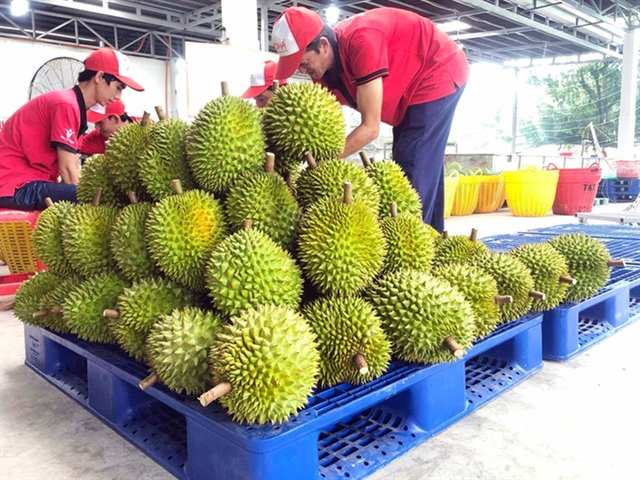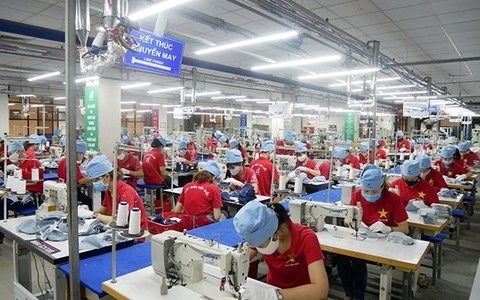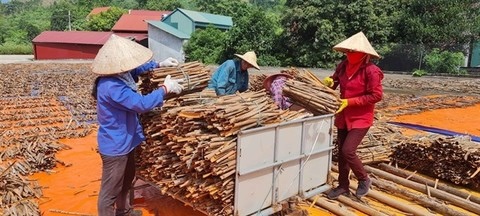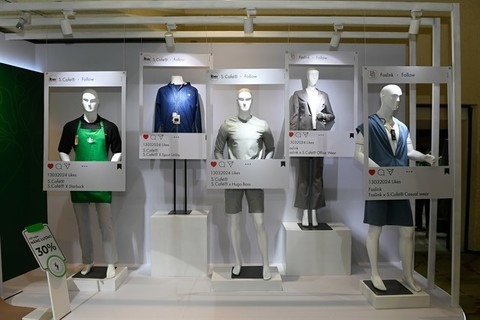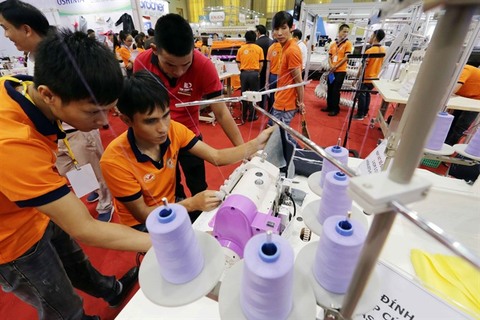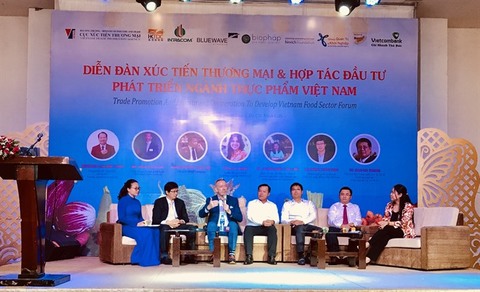Fast fashion set to transform market
Fast fashion set to transform market
The proliferation of foreign fast fashion brands in Vietnam is heating up the local sector and drawing in more and more newcomers, which forces local brands to transform and improve their capacity to compete.

Fast fashion on the rise
As Zara and H&M are thriving in the domestic fast fashion market, newcomer UNIQLO from Japan announced in late August its plans to open its first store in Vietnam in the autumn of 2019.
Unlike H&M and Zara, which serve the latest fashion trends, UNIQLO will also meet other customer demands by offering innerwear, loungewear, and swimwear. UNIQLO’s different customer approach is expected to add dynamism to the market.
Vinh Ha from Hanoi, who has three years of experience working in Japan, said, “UNIQLO is mainstream in Japan. People like UNIQLO’s products because of their comfortable and simple style. UNIQLO’s collections keep pace with new fashion trends. I once read a Japanese article saying that UNIQLO’s sales revenue in Japan is higher than that of Zara and similar to H&M. I think UNIQLO could really take the fight to Zara and H&M in Vietnam.”
UNIQLO’s announcement, along with Zara and H&M’s recent plans to expand the number of their outlets, show that fast fashion is on the rise, amid the country’s fast-growing economy as well as the changing shopping behaviour of Vietnamese people.
According to London-based Euromonitor International, Vietnam is experiencing a shift from middle to higher incomes, which is expected to lure in even more retailers in the future.
“More and more Vietnamese consumers become aware of higher-quality goods and are willing to pay more. These factors resulted in Vietnam becoming a good market for fast fashion brands,” read a 2017 report on Vietnam’s apparel sector.
A survey conducted by Asia Plus Inc. with 512 male and female respondents between the ages of 18 and 39 also showed that fashion is one of the categories drawing the highest interest. The rate was especially high among female respondents and those who earn more than the average household income.
Foreigners’ take on Vietnam
It is easy to see that, as many players join Vietnam’s high-potential fast fashion market, the competition between the newcomers and existing players, as well as between foreign brands and local brands, is becoming more heated.
Talking about this fierce competition, an H&M representative told VIR that each brand has to try its best to offer the highest-quality products and the best services to customers, at the most reasonable price. Specifically, H&M runs with the motto “Fashion and quality at the best price in a sustainable way”.
“Customers can always find something suitable at H&M. At H&M, fashion is reserved for everybody,” said the representative.
In fact, H&M is looking at bright prospects in Vietnam. Between December 1, 2017 and May 31, 2018, its revenue reached $1.43 million, equalling average daily revenue of $7,974.
Unlike H&M’s motto, the philosophy of UNIQLO’s LifeWear line-up focuses on simplicity, quality, and longevity. A representative of the Japanese brand told VIR, “This is about constant innovation, the continuous pursuit of more lightness, better design, and greater comfort in the lives of our customers.”
Winning the market
Among the huge spread of foreign brands, local fashion still holds the trust of a large number of Vietnamese people. According to a recent survey by Tokyo-headquartered market research firm Asia Plus, Blue Exchange, NEM, Ninomaxx, and Canifa rank among the 10 most favoured brands in Vietnam, where Zara ranks second and H&M eighth.
In fact, the Vietnamese taste for clothes shopping mostly depends on the price. The survey stated that Vietnamese average spending on fashion was VND550,000 ($24.3) per month, and only 7 per cent of Vietnamese people spend more than VND1 million ($44.24) per month on fashion items. This average spending of $24.3-44.24 is quite small compared to the average price of $44.24 for one fashion item in H&M and Zara stores.
Vietnamese preference for reasonable prices may be the main reason behind the domestic brands receiving huge local favour. The local brands’ average price of VND250,000-500,000 ($11-22) on one item, much lower than the average price of Zara and H&M clothes, can easily get a large number of consumers to loosen their purse strings, as the prices fit their conditions better.
However, in the long-term race to conquer consumers’ hearts, catching consumers’ fashion demand is the most important factor. Zara and H&M, with a huge force of designers and co-operation with well-known designers like Karl Lagerfeld and Balman, easily update to new fashion trends and offer new models every one to two weeks.
Thus, within one year, Zara and H&M offer 26-52 launches of new products, while the majority of domestic brands only focus on four seasonal launches.
In fact, the foreign brands’ strategy is effective in Vietnam. Since they first entered Hanoi last November, VIR observed that their stores commonly receive a high number of customers. In addition, a large number of promotions helps them to lure more customers.
Since H&M launched its first store in Hanoi, it rolled out a total of nine sales promotions. Similarly, Zara offered nine sales promotions in Vietnam in 2017.
Meanwhile, Vietnamese companies usually stage two large promotion events a year, around March 8 (International Women’s Day) and October 20 (Vietnamese Women’s Day), with the addition of the usual sales at the end of summer and winter.
It is easy to see that Zara and H&M are showing their extensive experience when drawing in Vietnamese customers, despite only having set foots in the country very recently. Both companies know that the demand for fashion is higher than the demand for low prices, especially since the Asia Plus survey stated that fashion is one of the categories given the highest priority in Vietnam.
According to statistics by London-based Business Monitor International, the total value of the Vietnamese fashion market hit $3.8 billion in 2018, with spending on clothes accounting for more than $3.5 billion. The market’s value is forecast to expand to $5.08 billion by 2021, including $4.7 billion of spending on clothes.
In addition, with an annual growth rate of 10 per cent during 2017-2021 as well as an increased presence of foreign brands in Vietnam, competition on the domestic fashion market is forecast to become fiercer.
Expansion
With its impressive growth rate, the Vietnamese fashion market is quite attractive for foreign brands. It is therefore understandable that those already present in the market are looking to expand scale.
After having opened four stores in Vietnam, including the latest one on July 28 this year in Hanoi, H&M is planning to open two more stores, one also in Hanoi and another one in Ho Chi Minh City.
“Opening six stores in a single year is clear evidence of H&M’s popularity in Vietnam. In the near future, we will definitely look for further new locations to open many more stores in Vietnam,” H&M’s representative told VIR.
Even before having actually opened its first store in the country, UNIQLO also keeps an open mind about expanding in the market.
“For now, we will focus on succeeding with our first store. We will decide on expansion plans once we have established a solid foundation for our first store,” the representative said.
As the foreign firms intend to expand their presence on the market, local firms have shown weakness in the battle. Due to the fierce competition, Vietnam’s once iconic brand Ninomaxx had to narrow its scale from over 200 stores to just shy of 60 stores across the country. Another local brand, Foci, which used to cover the country with 60 stores, had to close all its stores in late 2012, as it had no way of dealing with the space expenses.
Asked about the reasons behind this backtracking, Vo Van Quang, brand expert and marketing and brand strategy consultant, told VIR that in addition to the price, marketing strategy is also an important factor that impacts the success of the brands.
“Both foreign and local fashion brands have their advantages and disadvantages. Notably, although Vietnamese fashion producers have advantages in low cost, they still lack international marketing capacity and are far away from building global fashion brands,” Quang added. “In the fierce competition, it will not be enough for local fashion brands to improve quality and create new models; they will have to draw up appropriate market strategies to promote their brands. Canifa is a great example.”
After making a name for itself with woollen products, Canifa decided to expand its customer and material base. The brand has built its image by sponsoring reality television programmes, including Vietnam’s Next Top Model and Project Runway, and then co-operating with the programmes’ models and designers. This way, Canifa not only collected insights from “young blood”, but also lured in a large number of customers who watched these programmes.
Quang also stated that the reason behind the success of international brands is that domestic firms cannot cater to the needs of customers, either in terms of cost or quality or by following the newest trends in fashion. Thus, it will be vital for Vietnamese fashion brands to become more professional.
The creation of marketing strategies will help these firms make better decisions on issues ranging from design and materials through selecting the optimal seasonal product assortment to the investment plan to expand their store systems.


